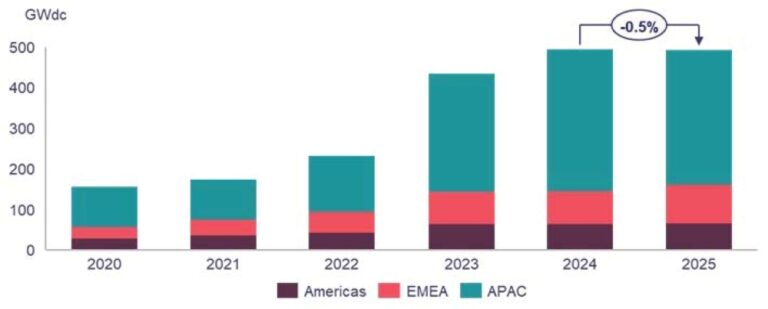January 22, 2025

Installed solar capacity reached new heights in 2024, but growth will come to a standstill in 2025 amid several industry uncertainties, according to a new report.
Wood Mackenzie recently released the “Global solar energy: four things to watch out for in 2025The report, which shows several limitations such as policy uncertainty, protectionist measures and interconnection and transmission bottlenecks, will stall the annual growth trend of solar deployment.
Key themes to watch for include: adapting to a new, more uncertain policy paradigm, capitalizing on data center growth, rationalizing production, and a new era of asset efficiency.
The solar industry adapts to a more uncertain policy paradigm | The global solar market reached an installed capacity of 495 GWdc in 2024, an increase of 14% from 2023. However, the growth trend is likely to change course in 2025, according to the report.
“Solar deployment will slow in many countries as policy changes become reality,” said Sylvia Leyva Martinez, principal analyst, Utility-scale solar PV, North America for Wood Mackenzie. “Post-election uncertainty, declining incentives, energy sector reforms and a shift to less ambitious climate agendas will leave solar installations stagnant at 493 GWdc after years of exponential growth.”
Solar energy benefits from the growth of data centers | The demand for data centers will increase due to the adoption of artificial intelligence. While future growth in data center demand is uncertain, Wood Mackenzie is tracking more than 100 GW of proposed data centers. Even if only 50 GW of this capacity is added over the next five years, demand growth could be as high as 10-20% in many regions of the United States over the next five years.
“Data center demand for robust, zero-emission capacity will reshape the origins and development of solar projects,” said Leyva Martinez. “A greater share of solar projects will involve wind, storage and/or natural gas to meet higher energy needs, and we will see innovation in contractual terms, business models and system architectures. Data center-driven competition for energy will increase solar purchase agreement (PPA) prices.”
2025 will be the year of rationalization of production. | According to the report, after two years of low solar panel prices due to global overcapacity, module prices will rise to offset significant profit losses suffered by manufacturers.
“China will remain the dominant manufacturing center, and emerging hubs in India, the US and the Middle East are expected to add at least 100 GW to global solar production capacity,” said Yana Hryshko, managing consultant and head of global supply chain for solar energy. research for Wood Mackenzie. “Coordination by Chinese manufacturers, supported by the Chinese government, will be key to achieving industry rationalization.”
Technology shifts in solar energy equipment will usher in a new era of asset efficiency. | “The voltage converter architecture will increase to 2000 Vdc, reducing costs and improving scalability,” said Sagar Chopra, senior solar research analyst at Wood Mackenzie. “AI-powered smart trackers will increase efficiency, and robots will be increasingly used in construction and maintenance to tackle rising labor costs and shortages. The decades-long path of continuous improvement in solar technology still leaves plenty of room to continue.”
Read the entire report here.
Tags: Wood Mackenzie


